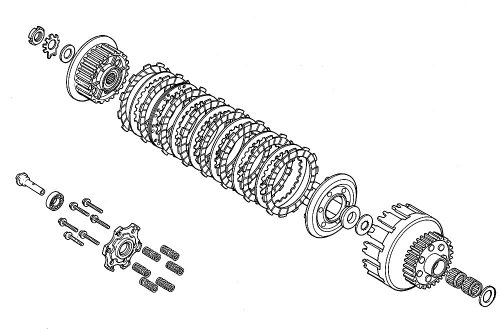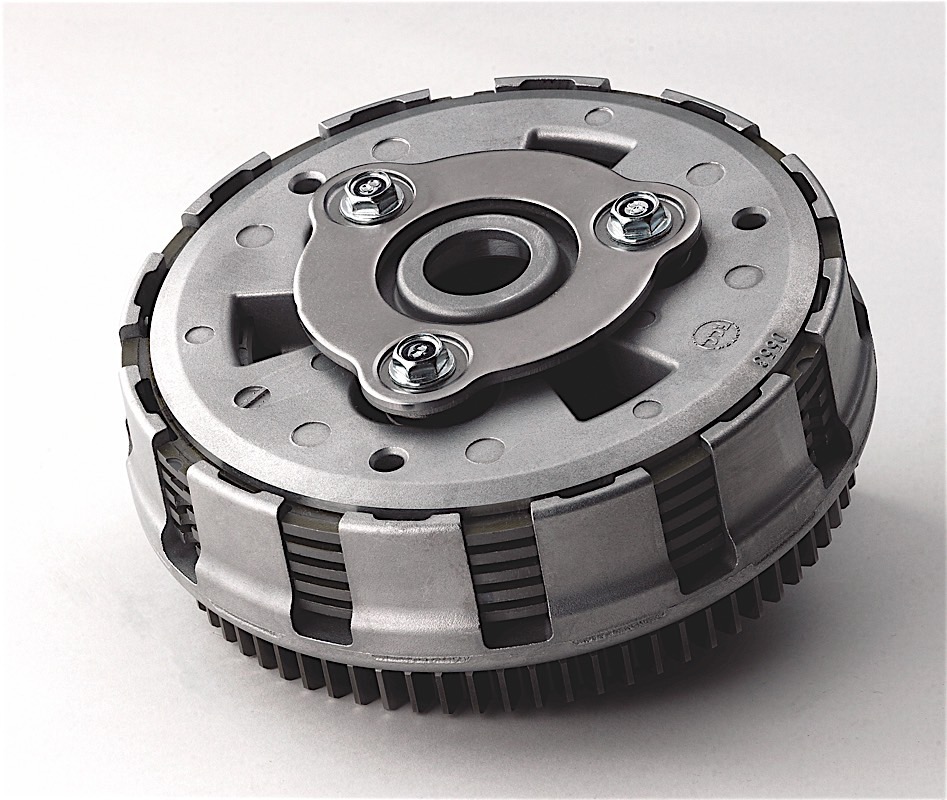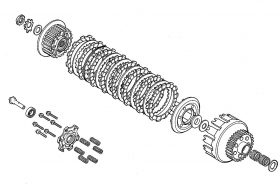A simple mechanical device that connects your engine’s power to the driveline.
A clutch is a necessity, and it serves only one function: to couple and uncouple the engine from the transmission. This function actually serves two purposes: to allow you to get going from a stop by gradually applying the engine’s power to the transmission and therefore to the rear wheel; and to help change gears by releasing the loads on the transmission, allowing the shift dogs to move between the gears. Here I’ll explain how a clutch works, the different types of clutch and how to diagnose some common problems.
 A single-plate clutch consists of a flywheel that is directly connected to the end of the crankshaft, a friction disc that is connected to the transmission input shaft, and a pressure plate that has a spring-loaded moveable plate that pushes onto the friction disc when the clutch is released, thus pressing it onto the flywheel and transferring power to the transmission. Radially mounted within the friction disc is a series of springs that absorb some of the shock when the clutch is released. This is the most common type of clutch in manual automobiles, and has been used in the past on BMW Boxers and is still used on Moto Guzzis. This is also a “dry” clutch, meaning it is not bathed in oil.
A single-plate clutch consists of a flywheel that is directly connected to the end of the crankshaft, a friction disc that is connected to the transmission input shaft, and a pressure plate that has a spring-loaded moveable plate that pushes onto the friction disc when the clutch is released, thus pressing it onto the flywheel and transferring power to the transmission. Radially mounted within the friction disc is a series of springs that absorb some of the shock when the clutch is released. This is the most common type of clutch in manual automobiles, and has been used in the past on BMW Boxers and is still used on Moto Guzzis. This is also a “dry” clutch, meaning it is not bathed in oil.
The advantage of a single-plate clutch is that it is simple, and because the single friction disc has a large surface area, it can take a lot of abuse. The disadvantage is that because it is sandwiched between the engine and the transmission, the latter must be removed to replace it, which can be costly.
The most common type of clutch on a motorcycle is the multi-plate clutch. It consists of an outer basket that is connected to the crankshaft by either a chain or gears (called a primary chain or primary gears) and has several slotted fingers around its outer circumference. There’s a clutch hub that resides inside the basket that has splines on its outer circumference and is connected to the transmission input shaft, and there are several friction and steel plates.
The friction plates have nubs around their outer circumference that slide into the slotted fingers on the clutch basket, while the steel discs are splined on their inner circumference and slide over the clutch hub. These plates are stacked alternately (friction, steel, friction, etc.) inside the basket, and although their individual mating surfaces are small compared with a single-plate clutch, their combined surface can be greater. A pressure plate on the outside of the entire assembly presses all the plates together when the clutch is released, thus transferring engine power from the basket to the hub, and into the transmission. One of the steel plates is called a spring plate, and it consists of a flat spring sandwiched between two thinner steel plates, with the whole lot riveted together. This helps smooth clutch action, while some radially mounted springs in the clutch basket help absorb the shock when the clutch is released.
The main advantages of the multi-plate clutch are that it is compact and lightweight, and it can get away with lighter spring pressure for lighter lever effort. It is, however, more prone to wear out quickly under heavy use owing to the smaller surface area of the individual friction plates. Most multi-plate clutches are “wet,” meaning they are bathed in oil to reduce wear and provide cooling. Dry multi-plate clutches were also once more common, and were used in Ducatis and older Harleys, but they’ve been phased out.
There are four main problems you might encounter with a clutch: dragging, slipping, grabbing or chattering. If a clutch drags, it’s usually related to the adjustment of the clutch cable if it is a mechanical clutch. If it’s hydraulically actuated, it probably means there’s air in the hydraulic system, something a good bleeding will resolve. Another reason a clutch can drag is if the plates are warped because of high heat, in which case it’s due for replacement.
If the clutch slips, it might be due to a maladjusted cable. Make sure you have sufficient end play at the lever according to manufacturer’s specs (not necessary on a hydraulic system). The clutch might also be worn out, in which case it’s time for a new one.
If the clutch grabs, the most likely culprit is a spring plate in which the spring has failed. This is most likely due to high mileage or age. This plate is available separately, so you need not replace the entire clutch if not necessary.
If the clutch chatters, it’s most likely because the damping springs in the friction disc (single plate) or clutch hub (multi plate) have either collapsed or have broken and need to be replaced. These, too, are available separately.
Don’t forget about proper maintenance, as this will ensure you get lots of mileage out of your clutch.
Technical articles are written purely as reference only and your motorcycle may require different procedures. You should be mechanically inclined to carry out your own maintenance and we recommend you contact your mechanic prior to performing any type of work on your bike.











